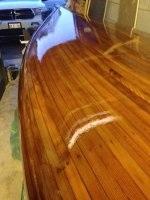So, a little update on this topic...
As I posted in my Hiawatha build, after doing much research, I chose Interlux Compass Clear Polyurethane Varnish. Now, because I have not used this particular varnish before, I really had to go with reading about others experiences with this product.
Like many comments, this varnish is not difficult to apply, and has very good leveling characteristics. I applied it using a thin foam roller, and then followed it up by tipping it off to rid the surface of bubbles. As all have stated, you must keep a leading wet edge otherwise you will have an issue transitioning from one section to another. I will say though, that this is a very slow drying product, so don't leave yourself short of time to get your coats done. You'll be sorry you did. I have applied 3 coats of 4, so far, and it has taken on average 2 full days before I can touch the surface without leaving a finger print, and another day before I can sand it for the next coat. Too long to wait for many people out there. Could be humidity affecting curing time.
I am sanding with 320 grit between coats, with the last coat getting a 600 grit wet sand to knock down the sheen a little, as I am not a huge fan of something as glossy as I see here. You could probably get away with not sanding between 1st and 2nd coat, but I didn't. Too obsessive I guess.
I'd like to tell you how durable the finish is out in the real world, but I haven't had it in the water yet, nor have I run across any gravel. Time will tell on that, but for now, it seems to be the correct choice for me. I of course will post all about the finish once it has been "tested" so you can also make an informed choice for your needs.
Here's a couple of close-ups that will hopefully help show the finish depth and sheen.


Hope this has been helpful
Momentum


